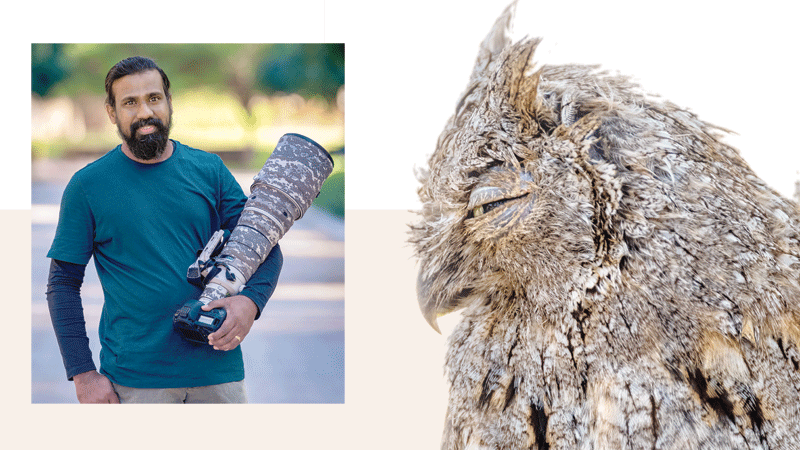

As birdwatching spots are on the wane in a city like Muscat, many bird enthusiasts are finding it difficult to spot new and rare birds. Still, Shine Balan is of the view that the landscape of Oman fascinates him and is curious to spot new birds at every instant
Diederik Cuckoo, Cormorant, Strawberry Finch, Namaqua Dove, or Pallid Scops Owl are some of the rare birds found in the Sultanate.
All these have been captured on camera by a young Indian resident in Oman in pursuit of his love for bird photography.
“Bird and wildlife photography takes me closer to nature,” mentions Shine Balan, an automobile mobile technician at Royal Court Affairs.
His deep passion for photography developed into a creative pursuit for bird photography in the past six years.
Having started with landscape photography, Shine moved to bird photography only recently.
Since then he can be seen scouring the wetlands in Al Seeb, areas beyond Barka during his spare time and weekends to capture migratory birds on his Nikon D5300.
The shutterbug has so far captured some of the rare birds like Egyptian Nightjar, Imperial Eagle, Eurasian Dotterel or the Eurasian Scops Owl which he claims are his prized discoveries.
The Egyptian Nightjar is a medium-small Nightjar with a powerful flight which he found during his rounds along the Al Batinah highway.
As birdwatching spots are on the wane in a city like Muscat, many bird enthusiasts are finding it difficult to spot new and rare birds. Still, Shine is of the view that the landscape of Oman fascinates him and is curious to spot new birds at every instant.
His passion with photography began when he acquired a Nikon D5600 camera, an entry level model.
Recently he and his friends went scouting for an early morning trip to spot Egyptian Nightjar, a rare species. A rare camouflaged bird, it is seen usually in the wild.
They set out from Muscat to Al Batinah on a two-hour journey to shoot the bird on camera.
With a picture of the bird sourced from the Internet, four photographers namely Shine, Bavish Kizhakoodan Balan, Althaf Abdul and Suvi John were right on spot. They split separately and went in different directions in search of the bird.
After searching for hours, a bird just flew from somewhere and landed right in front of Shine as if the bird came to visit him. He recalls his happiest hour ever when he got the bird at an arm’s distance.
Soon his friends landed on the spot and they waited for the bird to get settled. As Nightjar was in a bit of a relaxing mood enabled them to shoot the pictures.
Photography is a deep passion for ‘backbenchers’ from Kerala who are working in various companies in Muscat.
The inception of the Backbenchers group was conceived when they came together as friends with a passion for photography. This was constituted as a knowledge sharing platform for all of them together in a mutual symbiotic association.
Gradually this aroused Shine’s interest in bird photography as he has been focusing more during the last two years.
“The Sultanate,” he says, “boasts of a good bird population, species resident and migratory both combined.”
Most members from the Backbenchers are also with Friday Shoot Out Muscat (FSO) and Indian Social Club Photography Group (ISCPG), a photo enthusiast group in Oman.
The association with the group contributed to his learning curve thereby enhancing his skills with the camera during the early years.
Says Shine: “Initially I stepped into photography as a landscape photographer with my entry level camera. Later, after joining FSO, I was able to meet with professionals in the field. We were able to share knowledge to improve my raw skills. After joining the Backbenchers group, I started travelling a lot and got more interest in bird photography. It is more challenging and adventurous with each journey. I was happy to see different birds which I had never seen in my life. Bird photography helped me study more about birds and their behaviour.”
As one who has studied the nature of birds over the years, Shine says “birds are shy, they do not like the presence of others. To take better shots, we need to be closer to the birds as much as we can. You will need some special skills and equipment to capture attractive avian images.”
He now desires to capture barn owls on his camera as it is the most widely distributed species of owl in the world and the most widespread of all species of birds.
“To make a better shot we need to compromise, learn to be calm and quiet, and avoid taking fast movements. Some birds do camouflage. Sometimes we spend hours or revisit the same place to get a single shot for a bird, but I never get disappointed as I know one day they will come in front of me,” he reasons.
Liju Cherian
@cherianmathiker
Oman Observer is now on the WhatsApp channel. Click here



